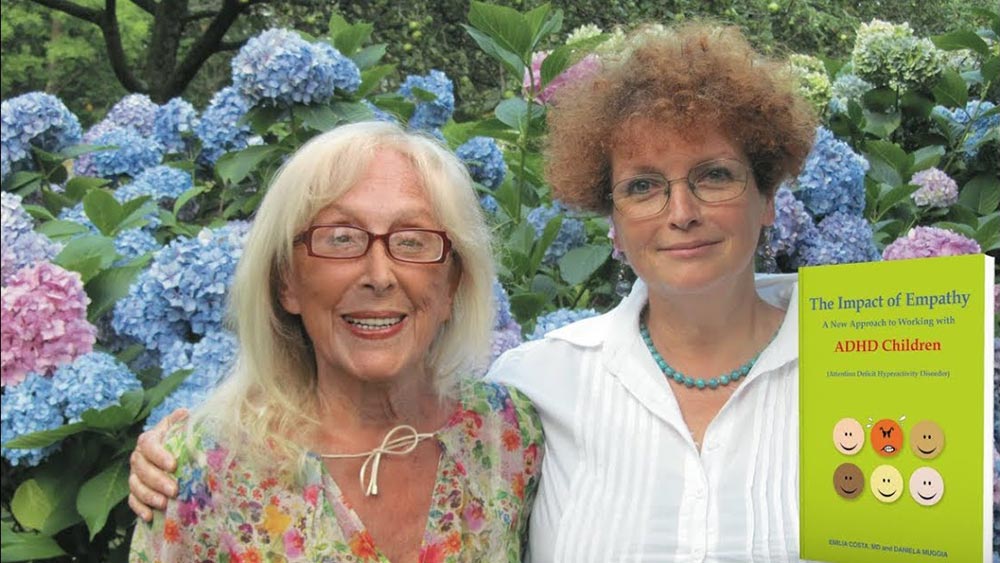The U.S. Centers for Disease Control estimated that in 2011, 6.4 million children — or 11 percent of American children ages 4 to 17 — had a diagnosis of attention deficit hyperactivity disorder (ADHD). Clinical and therapeutic experience tells us that most of the discomfort and psychological suffering of educators and therapists facing children with ADHD is inherent to their subjective interpretation of the child’s behavior, conditioned by individual experiences that sometimes do not allow them to see the child’s real needs. To prevent the child from harming themselves and others, we quickly jump to the gun: we want to ‘fix’ this immediately, and as a result these young people are frequently subjected to heavy dosing and often-risky psychopharmacological drug therapies that can have negative long-term side effects.
What if there was an effective and non-invasive way to help?
An unusual inspiration
An unusual inspiration is appearing in our culture, one that takes its cue from the other end of life.
It is presented in a new book called The Impact of Empathy—A New Approach to Working with ADHD Children, which refers to the Empathic Care of the End of Life (ECEL), a method awarded the Italian Terzani National Prize for the Medical Humanities. It has been included in numerous masters degree programs in Nursing, Psychooncology and Thanatology departments at universities in Italy and other countries, as well as in projects of Continuing Medical Education (CME) conducted in hospitals and hospices for staff training purposes.
One of the Authors, Professor Emilia Costa, is an Italian psychiatrist who specialized in treating children with ADHD, so in a sense it was ‘normal’ for her to write this book; while her co-author, Daniela Muggia, specializes in death and dying.
Muggia developed ECEL during her 22 years of experience with the dying. Unexpectedly, this method brings new light into the ADHD approach, uniting the fields of Tibetan Thanatology (science of death and dying), neuroscience and an understanding of quantum physics to illustrate that the state of inner peace one achieves through meditative training, has a significant effect on soothing those afflicted by confusion and anxiety, provided they are capable of absorbing this state empathically.
How does it work?
Similarities between those who are at the end of life and those who are at the beginning of life are striking: both are very empathic by nature, and directly experience the state of mind of those in their surroundings. Both, when suffering a discomfort, cannot verbalize it.
So, there are two things to do:
- Find a fresh vision unaffected by past conditioning that is able to perceive the child’s real needs that lie under the behavior. This is a complete training in ‘empathic listening’ through meditation;
- Root our relationship with a difficult child in deep peace, which might in turn be felt empathically and recognized by the child with ADHD. He or she will feel the urge to learn how to achieve that state in an independent way, which in turn shall help them to develop coping capacity and skills for long-term self-care.
Both things are not only very useful, but can bring great strength and peace to the moment, which can, again, be directly absorbed by the child.
When a caregiver is trained to access and maintain a peaceful and compassionate state of mind, children can empathically ‘taste’ that same state from within. Therefore the approach described in the book—both the ECEL method, and other empathy-based techniques deriving from Jung— addresses mainly the adults (parents, teachers, caregivers), teaching them how to accomplish and maintain a state of deep inner peace, no matter what the ADHD child does.
No chemical straitjackets, no physical containment: “just become peace yourself, no matter what, and the childrens’ repeated experience of this will enable them to not only desire, but replicate this state within themselves.” In this sense, this approach differs from many others that also use meditation with ADHD children: here, children are not directly taught meditation, they just experience empathically the fruit of it repeatedly, as a new form of non-conflictual relationship with the adults and, in some case, with the rest of their schoolmates. Sometimes, it is their first experience of true mind peace.
The wealth of resources and scientific information available in this book is impressive: for instance, you will discover a rich offering of high-level research done on meditation results on ADHD children, a vast series of scientific studies, both pilot studies and peer-reviewed ones, conducted on a number of methods based on different meditation techniques that have been applied indirectly or directly to children with ADHD.
You will find what benefits were found in 2012 in 91 American schools of various kinds and levels, scattered over thirteen states, where one of the available trainings lasted from three to six months, with daily or twice-weekly sessions of ten to forty minutes each (practicing with children Mindfullness Meditation or Transcendental Meditation (TM):
- days of absence: decreased by 25%;
- suspension days: decreased by 38%;
- significantly improved scores on validated attention skills tests;
- aggressive behavior: decreased by 8%;
- rules infraction: decreased by 50%.
You might be surprised as well to learn that approximately 600 studies, of which more than 350 have been peer-reviewed, were conducted on TM, for example, and you will become familiar with them: in the book we explain things in a way that the reader enters the lab and understands absolutely everything.
You will read about the ‘historical’ studies on meditation led by important neorosicentists that encouraged many more to inquire into the matter or to build pioneer meditation-based projects in schools, where the innate value of “troublemakers” is recognized, instead of perceiving them as “broken” children to be “fixed” chemically, and upon whom others merely project concepts.
All these benefits occur without the side effects of medication, such as sleep disturbances, poor appetite, weight loss, stunted growth and mood disorders, which then need to be treated with further medication, which are often unsuitable or children, and which in the long-term are suspected of leading to a higher risk of cardiac problems and sudden death, liver damage, psychiatric disorders, as well as higher rates of delinquency in adulthood, drug use and growth retardation, as highlighted in a 2010 study sponsored by the Ministry of Health of Western Australia and many other studies.
You will become enthusiastic about the UCLA Map Project, or the Shamatha International Project, modeled on the Human Genome Project, bringing together many researchers and scientific laboratories from all over the world, sharing their discoveries to bring together teachers and meditators from the different Buddhist schools to explore the methods and the most favorable conditions for achieving, at the present time, mastery of a basic meditative techniques involving attention, traditionally called “shamatha.”
And when you start wondering whether and how do school systems react to all this scientific data, you will be shown amazingly inspiring projects being run throughout the world: from the Alice Project in India and several European countries, involving thousands of students, to the Quiet Time Program involving more than 200,000 students, mainly in U.S.
All of this is supported with plenty of case stories: some tender, some amusing, all very touching and alive because they are coming straight from the real experience of both the authors’ work with young Italian ‘troublemakers’ whose lives are now endowed with a better chance of success.
Co-authors of The Impact of Empathy
 Daniela Muggia is a Thanatologist and the winner of the prestigious Terzani Award for the Medical Humanities in 2008. For almost 30 years she studied the Tibetan tradition of death and dying with Sogyal Rinpoche, author of the ground-breaking Tibetan Book of Living and Dying. She also trained with Cesare Boni, a professor and teacher of Master classes in Thanatology, the study of death and dying, at Naples University. After more than 20 years of working with the terminally ill, she has developed the ECEL method, Empathic Care at the End of Life, one of the most popular courses taught in hospitals, hospices and for Masters degree programs at universities in Italy and other countries.
Daniela Muggia is a Thanatologist and the winner of the prestigious Terzani Award for the Medical Humanities in 2008. For almost 30 years she studied the Tibetan tradition of death and dying with Sogyal Rinpoche, author of the ground-breaking Tibetan Book of Living and Dying. She also trained with Cesare Boni, a professor and teacher of Master classes in Thanatology, the study of death and dying, at Naples University. After more than 20 years of working with the terminally ill, she has developed the ECEL method, Empathic Care at the End of Life, one of the most popular courses taught in hospitals, hospices and for Masters degree programs at universities in Italy and other countries.
 Emilia Costa, MD, a former professor of psychiatry and psychotherapy at La Sapienza University in Rome has authored over 360 pioneering scientific publications. She studied directly with some great masters—Carl Jung, Roberto Assagioli, an Italian Psychiatrist and pioneer in the fields of humanistic and transpersonal psychology, and Psychiatrist Gianfranco Tedeschi, founding member of the professional Jungian group, AIPA, in Italy. Currently, she is the Dean of a Scientific Committee of Pharmacovigilance with the organization, Hands off the Children, which works to inform teachers, parents, medical doctors and scientists about the danger of over prescription of drugs to children.
Emilia Costa, MD, a former professor of psychiatry and psychotherapy at La Sapienza University in Rome has authored over 360 pioneering scientific publications. She studied directly with some great masters—Carl Jung, Roberto Assagioli, an Italian Psychiatrist and pioneer in the fields of humanistic and transpersonal psychology, and Psychiatrist Gianfranco Tedeschi, founding member of the professional Jungian group, AIPA, in Italy. Currently, she is the Dean of a Scientific Committee of Pharmacovigilance with the organization, Hands off the Children, which works to inform teachers, parents, medical doctors and scientists about the danger of over prescription of drugs to children.
Title: The Impact of Empathy—A New Approach to Working with ADHD Children
Author: Emilia Costa and Daniela Muggia
Price: $18.99 U.S.
Publisher/Imprint: BlossomingBooks, US subsidiary of Edizioni Amrita, srl
Format: Trade Paperback, ebook











